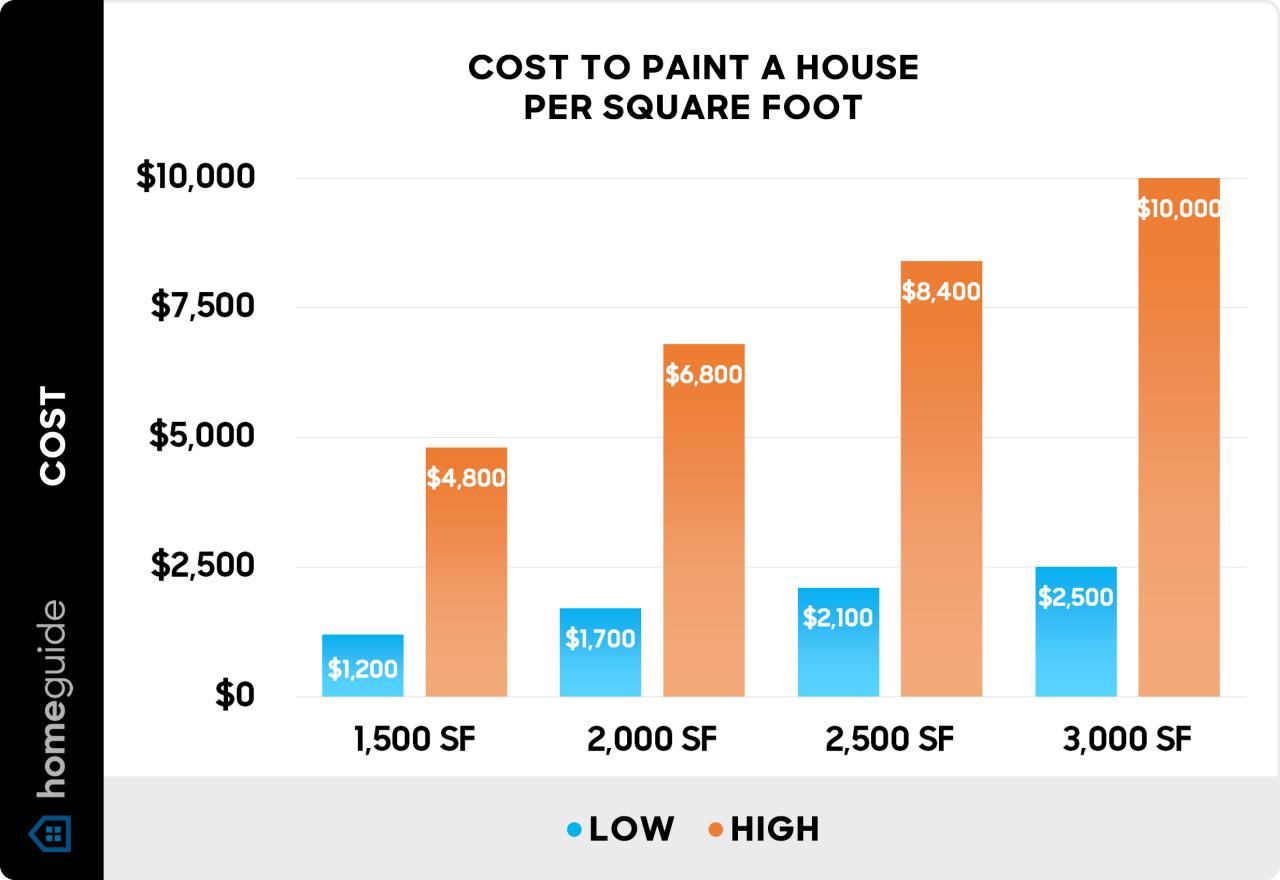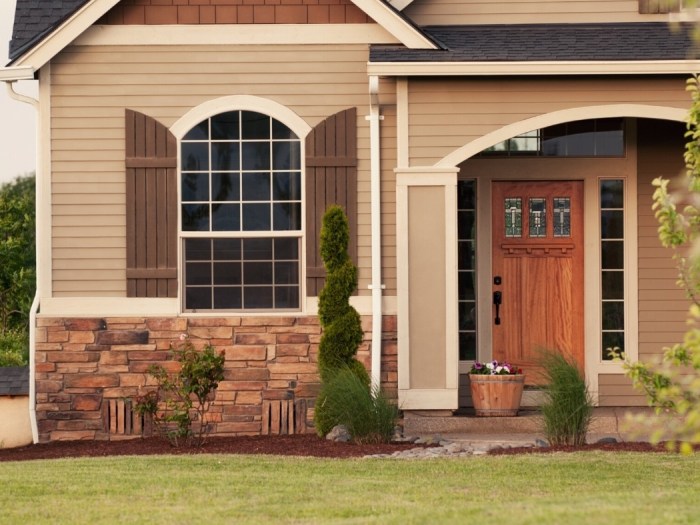Exterior House Painting Costs Explained: Budgeting for 2025 Projects
Exterior House Painting Costs Explained: Budgeting for 2025 Projects sets the stage for this enthralling narrative, offering readers a glimpse into a story that is rich in detail with a casual formal language style and brimming with originality from the outset.
As we delve into the intricacies of exterior house painting costs and budgeting for upcoming projects, the wealth of information presented promises to enlighten and empower readers in making informed decisions.
Factors Influencing Exterior House Painting Costs
When budgeting for an exterior house painting project, it's important to consider various factors that can influence the overall cost. Understanding these factors can help you plan accordingly and avoid any unexpected expenses.
Surface Area to be Painted
The size of your home's exterior plays a significant role in determining the cost of painting. A larger surface area will require more paint and labor, ultimately increasing the overall cost. For example, a two-story house will cost more to paint than a single-story home due to the additional square footage.
Preparation Work Needed
The condition of your home's exterior before painting can impact the cost. If there is extensive prep work required, such as repairing damaged surfaces, sanding, or priming, the labor costs will increase. Neglecting necessary prep work can lead to a subpar paint job and potentially higher costs in the long run.
Type and Quality of Paint
The type and quality of paint you choose will also affect the cost of the project. Premium paints may cost more upfront but can provide better coverage and durability, ultimately saving you money in the long term. Additionally, certain paint finishes like high-gloss or specialty textures may come at a higher price point.
Accessibility and Height of the Property
The accessibility and height of your property can impact the cost of labor. A property with difficult access points or tall heights may require specialized equipment or additional safety measures, leading to higher labor costs. Factors like steep roofs or intricate architectural details can also affect the overall price.
Location and Season
The location of your home and the time of year can influence the cost of painting. Prices may vary based on local labor rates, material costs, and seasonal demand. Painting during peak seasons or in areas with higher living expenses may result in higher overall costs.
Cost Breakdown: Materials vs. Labor
When budgeting for an exterior house painting project, it's important to understand the breakdown of costs between materials and labor. This breakdown can help you make informed decisions and plan your budget effectively.Quality materials play a significant role in the overall cost of an exterior house painting project.
High-quality paints and primers may come at a higher price, but they can provide long-lasting results and better protection for your home. On the other hand, cheaper materials may save you money upfront, but they could lead to more frequent repainting and maintenance costs in the long run.Labor costs are another crucial component of the total expenses for a painting project.
These costs are usually calculated based on factors such as the size of the project, the complexity of the job, and the experience of the painters. Additionally, factors like the location of your home, the accessibility of the painting area, and the time of year can also influence labor costs.
Quality of Materials and Cost
When it comes to materials, investing in high-quality paints, primers, and supplies can increase the overall cost of the project. However, these quality materials can result in a more durable and aesthetically pleasing finish that may require less maintenance over time.
It's essential to weigh the upfront cost against the long-term benefits when choosing materials for your exterior painting project.
Calculating Labor Costs
Labor costs are typically calculated based on the size of the project, the hourly rate of the painters, and the estimated time to complete the job. Factors like the complexity of the painting job, the need for additional prep work, and the use of specialized techniques can also impact labor costs.
It's advisable to obtain multiple quotes from different painting contractors to compare prices and services before making a decision.
Budgeting Tips and Strategies
Budgeting for an exterior house painting project is crucial to ensure that you stay within your financial limits while still achieving the desired results. Here are some tips and strategies to help you effectively budget for your painting project.
Prioritizing Expenses and Allocating Funds Wisely
When budgeting for your exterior house painting project, it's essential to prioritize expenses based on what is most important to you. Allocate funds wisely by focusing on key areas that need the most attention, such as repairing damaged surfaces or investing in high-quality paint.
By prioritizing expenses, you can ensure that your budget is used efficiently and effectively.
Saving Money Without Compromising Quality
There are several strategies you can use to save money on your exterior house painting project without compromising on quality. Consider doing some of the prep work yourself, such as cleaning and sanding surfaces, to reduce labor costs. Additionally, compare prices from different paint suppliers and contractors to find the best deal without sacrificing the quality of materials or workmanship.
Remember, it's possible to achieve a beautiful and long-lasting paint job without breaking the bank.
Estimating Paint Quantities and Calculating Costs

Estimating the amount of paint needed for an exterior house painting project is crucial to staying within budget. By understanding different paint types and their costs per gallon, as well as calculating the total cost of paint accurately, you can ensure a successful and cost-effective painting project.
Estimating Paint Quantities Based on Surface Area
Before starting your project, calculate the total surface area to be painted. This includes walls, trim, doors, and any other surfaces you plan to paint. Measure the height and width of each surface and multiply them to get the square footage.
Add all the surface areas together to get the total square footage to be painted.
- Consider adding an extra 10-20% to account for waste, touch-ups, and multiple coats.
Different Paint Types and Costs per Gallon
There are various types of paint available, each with different costs per gallon. Here are some common paint types and their average costs:
| Paint Type | Average Cost per Gallon |
|---|---|
| Flat | $15
|
| Eggshell | $25
|
| Semi-Gloss | $30
|
| High-Gloss | $40
|
Calculating Total Cost of Paint
To calculate the total cost of paint for your project, use the following formula:
Total Cost of Paint = (Total Square Footage ÷ Coverage per Gallon) x Cost per Gallon
- Divide the total square footage by the coverage per gallon (usually listed on the paint can).
- Then, multiply the result by the cost per gallon of the paint type you have chosen.
- Repeat this calculation for each type of paint you plan to use on different surfaces.
Hiring Professional Painters vs. DIY Painting

When it comes to exterior house painting, deciding whether to hire professional painters or tackle the project yourself can be a tough choice. There are various factors to consider, including cost, quality, and time commitment. Let's explore the pros and cons of each option to help you make an informed decision.
Cost Comparison
- Hiring Professional Painters:
- Costs can vary depending on the size of the project, location, and the experience of the painters.
- Typically, hiring professionals can be more expensive upfront but may save you time and effort in the long run.
- Professional painters often have access to discounted materials, which can help reduce overall costs.
- DIY Painting:
- DIY painting can be cost-effective if you already have the necessary tools and equipment.
- You can save on labor costs by doing the work yourself, but keep in mind that it may take longer to complete the project.
- Quality of work may vary depending on your experience and skill level.
Quality Considerations
- Hiring Professional Painters:
- Professional painters have the experience and expertise to deliver high-quality results.
- They can provide recommendations on paint types, colors, and finishes that best suit your home.
- Professionals can also ensure proper surface preparation, which is crucial for a long-lasting paint job.
- DIY Painting:
- The quality of DIY painting may depend on your level of skill and attention to detail.
- You may have more control over the final outcome and can take pride in completing the project yourself.
- However, mistakes or lack of experience can lead to subpar results and the need for costly repairs.
Decision-Making Factors
- Consider your budget and timeline when deciding between hiring professionals or DIY painting.
- Assess your skill level and willingness to learn new techniques before taking on a painting project.
- If you value quality and convenience, hiring professional painters may be the best option for you.
- On the other hand, if you enjoy hands-on projects and are confident in your abilities, DIY painting can be a rewarding experience.
Summary
In conclusion, Exterior House Painting Costs Explained: Budgeting for 2025 Projects unravels the complexities of budgeting for exterior house painting, leaving readers equipped with valuable insights and strategies to navigate their upcoming painting endeavors with confidence and financial prudence.
General Inquiries
What factors can impact exterior house painting costs?
Factors such as surface area, paint quality, and labor rates can significantly influence the overall cost of an exterior house painting project.
How can one effectively budget for an exterior house painting project?
Effective budgeting for such a project involves prioritizing expenses, estimating paint quantities accurately, and exploring cost-saving strategies without compromising on quality.
What are the benefits of hiring professional painters over DIY painting?
Professional painters offer expertise and efficiency, but DIY painting allows for cost savings. Consider the trade-offs between quality and expense when making this decision.




